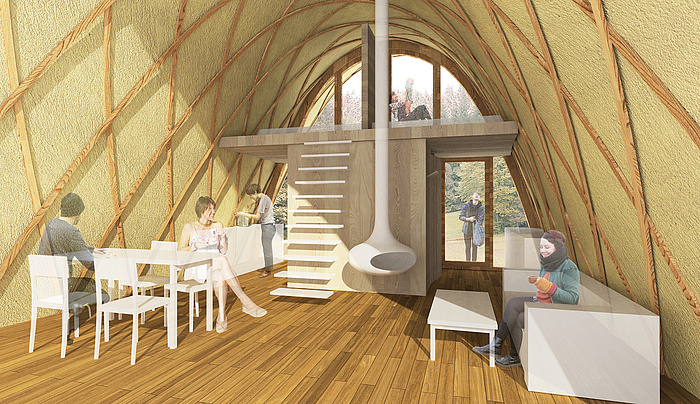Innovative: ecological lightweight construction
![[Translate to Englisch:] Grafische Darstellung des sattelförmigen Strohboid als geschlossener Wohnraum am Berg.](https://www.tugraz.at/fileadmin/_processed_/e/2/csm_Strohboid01_d485bd90de.jpg)
Lightweight construction made of wooden struts
Max Schade’s and Fritz Walter’s master’s thesis started with the idea of testing a lightweight construction system and demonstrating its potential. Lattice-work shells are the most efficient known structures, sometimes even lighter than the air which they traverse. Without technical aids, the design is so demanding that only a few prestige structures have been built, such as the multihall by Otto Frei in Mannheim. But this did not deter Andreas Trummer and institute head Stefan Peters, Dean of the Faculty of Architecture at TU Graz. They counted on the fact that the use of digital aids from the draft to the finished product would open up new potential for innovative construction methods.From “strawboid” to construction system
The result of this was the strawboid prototype, which was able to be ideally set up at the Austrian open-air museum at Stübing. Erected using wooden slats and straw in a sandwich construction, the structure has the building geometry of a saddle surface. Two wooden lattice-work shells run one above the other, and the intermediate space is filled with bales of straw. A sophisticated bentwood technology ensures that the desired curvature is achieved. Heated up and dampened by steam, beech wood, which is particularly suitable for this technique, becomes soft and pliable. And when cold, it has a stable shape and can bear loads. From experiences with build-it-yourself kits using precise plans, mechanical tests and calculations, a free-form design made of emission-free materials can be derived for other structures.90% energy savings – zero pollutants
The ecological assessment of the strawboid is remarkable. Compared to a traditional construction made of wooden profiles, the wooden lattice-work construction saves about half of the building material and compared to massive constructions, consumes up to 90% less manufacturing energy. The building including insulation is plastic and pollutant free and can be completely recycled after use.Sought-after approach
Straw as an ecologically high-quality insulation material is not new. Since the straw baling press was invented 150 years ago, the material has been used as a renewable insulating material and ensures home comfort. Plastered with clay, the bales are protected against fire and pests and are an ideal regulator of heat and humidity. The advantages of straw bale construction were obvious for Max Schade und Fritz Walter because the bales can be easily worked and are perfectly suitable for curved designs.
The prototype at Stübing is presented with a <link http: strohboid.blogspot.co.at _blank int-link-external external link in new>photoblog.
Kontakt
Assoc.-Prof. Dipl.-Ing. Dr.nat.techn.
Diploma thesis supervisor
Institute of Structural Design – ITE, TU Graz
Technikerstraße 4/4, 8010 Graz, Austria
Tel.: +43 316 873 6212
<link int-link-mail window for sending>andreas.trummer@tugraz.at
<link http: www.ite.tugraz.at _blank int-link-external external link in new>www.ite.tugraz.at




